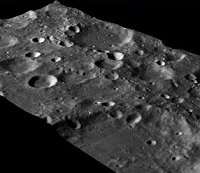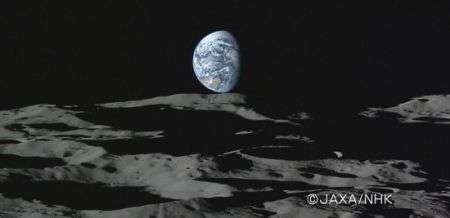Who's Orbiting the Moon?

The space around Earth is a busy place, as teeming with traffic as a roundabout. More than 500 active satellites are bustling about up there right now. Some are transmitting radio, television, and telephone signals; others are gathering information about Earth's atmosphere and weather; still others are helping people navigate down here; and the rest are conducting space research.
Soon the space around the moon will be busy too. China, Japan, India, Russia, and the US either have sent or plan to send satellites there for a bird's-eye view of lunar features and resources.
Why is the moon such a draw?
For one thing, it's there – close by. We can see it better than we can see anything else in space. And it's reachable, even by countries whose space programs are in their infancy. It represents a grand first step for them.
Indeed, two of those nations are already there: Japan and China are orbiting the moon right now.
Japan's Kaguya spacecraft, formerly known as SELENE, reached the moon in October 2007. Its mission: to make detailed maps of the moon's surface, to search for water (a key resource for future human landings) frozen in deep craters, and to study the moon's gravitational field.
Barbara Cohen, a lunar scientist and self-described "lunatic" at NASA's Marshall Space Flight Center, says "Kaguya is the Cadillac of missions right now. It is huge, consisting of three separate satellites, and has excellent instruments. It will do a lot of particles and fields work that no other currently planned orbiter will do. Plus it will be able to train all its instruments toward the same spot on the moon simultaneously."
Kaguya's main satellite carries 13 science instruments, including an HDTV (high-definition TV) camera, which is sending back incredible images of lunar landscapes stretching into the distance like an open road and Earth rising over the lunar horizon:

Barely a month after Japan reached the moon, China followed suit: China's Chang'e-1 spacecraft entered lunar orbit on November 5, 2007. During its 1-year mission, it will map the moon by taking three-dimensional images of the entire lunar surface. This satellite will send back the first detailed pictures of some areas near the poles where water ice is most likely to be found.
Chang'e-1 is the first in a series of three Chinese spacecraft: Chang'e-2 will be a lander with a rover, and Chang'e-3 will return moon samples to Earth. The Chinese hope someday to send humans to build a lunar outpost, but for now they're focusing on gathering knowledge and experience step-by-step.
Next month India plans to send its own Chandrayaan-1 probe to orbit the moon. In Sanskrit, "Chandrayaan" means "Moon Craft." A NASA-sponsored instrument, the Moon Mineralogy Mapper, will ride along and use an infrared spectrometer to survey the lunar terrain and give us a highly detailed picture of mineral locations. Chandrayaan-2, planned for 2010 or 2011, will place a robotic rover on the moon. The rover will wheel around on the lunar surface, pick up samples of soil or rocks, do chemical analysis, and send the data to the spacecraft orbiting above.
NASA is very much a part of this "Great Moon Rush." Later this year, the agency plans to launch the Lunar Reconnaissance Orbiter (LRO), a spacecraft bristling with instruments to map the moon and locate key resources ranging from water to building materials.
"The LRO mission will provide the best resolution images – at about 50 cm per pixel – out of all the instruments currently headed to the moon," says Cohen. "This means we will be able to see rocks that are about two feet in diameter. This lets us look at potential landing sites to assess the terrain and hazards for a human return. LRO will also have an instrument that flies 'tissue-equivalent plastic' to assess radiation damage to human skin."
In 2011 NASA's Gravity Recovery and Interior Laboratory, or GRAIL, will peer deep inside the moon to reveal its anatomy and history. This mission, part of NASA's Discovery Program, will fly twin spacecraft around the moon for several months to measure its gravity field in great detail and answer questions about how Earth and other planets in our solar system formed.
Both LRO and GRAIL will provide valuable information to help plan for a human US return to the moon in the next decade.
The US has already been there, you say? True, but we didn't stay long enough to do much more than scratch the moon's surface, literally. The pull to return is strong. Dr. Wesley Huntress, lunar advocate and Director Emeritus of the Carnegie Institution's Geophysical Laboratory, says it best:
"... many nations with emerging space programs have the moon in their sights. There will be a renaissance in lunar scientific exploration in the next several decades that the US will not want to miss. The pull of the moon to emerging space programs around the world can be a catalyst for a new era of space exploration; one of international cooperation ...."
No return would be complete without an original lunar pioneer: Russia. After racing to the moon in the 1970s, the USSR virtually abandoned lunar exploration. Russian scientists nevertheless continued to look longingly toward that silver orb in the night sky, recognizing its great worth for research. Now, the Russian space program, with an eye toward an outpost in the distant future, may launch its Luna-Glob project within the next several years. Plans include an orbiter that will deploy 13 probes, including penetrators and a lander, to answer questions about the moon's origin and search for water ice.
"There is a fair bit of overlap among missions, but this is okay in science," adds Cohen. "We will get more coverage and better resolution by being able to add together data from similar instruments. This is partly by design. NASA doesn't want an over-reliance on other countries to collect the data necessary for a human return to the moon. What if another country canceled its commitment to fly or their spacecraft failed? We rather fly our own missions with our own instruments to make sure we get our basic data, and then we definitely collaborate with other countries and missions to share, refine and improve the data."
How long will it take for the moon to be encircled with satellite traffic like Earth? Not very long, with the current moon rush. By the end of 2011, nine satellites could be buzzing around up there. That's a pretty good start.
Source: Science@NASA, by Dauna Coulter





















